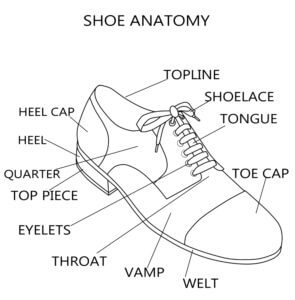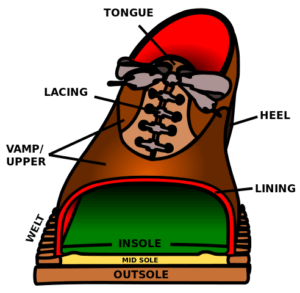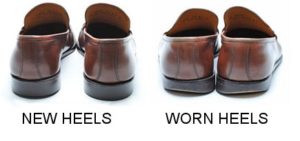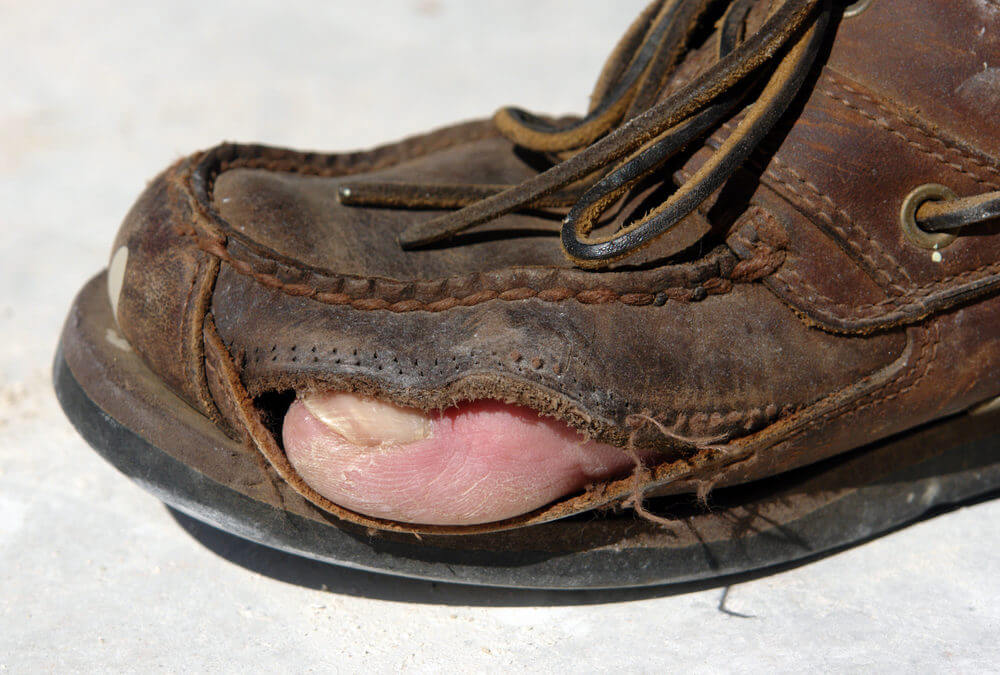Death or regeneration?

Figure 1: Shutterstock by Giorgio
Do we keep an old shoe buy a new shoe and see the death of that old familiar, or is regeneration possible? Let’s look at the everyday shoe. That is the workhorse shoe. When should our old shoes be replaced with new shoes? If you are like me shoes last a long time, but then we all have our favourites which might wear down faster. My blue trainers looked sad as the outer coat (the Uppers) were speckled with garden shed paint having been replaced as my best friend. Conversion to a workhorse is economically sound as you can keep shoes going for longer even if they are past their best. When should you chuck them out? How can you make them last longer? This is the subject of my article this week.The inevitable shoe burial (aka the dustbin) may be one of life’s lesser stressors but there are many things we can do to keep shoes lasting longer, and of course there is the foot health angle.
Basic anatomy of a shoe
 Shoes like humans have anatomical references so it is useful to consider the main parts of a shoe. The upper section is joined to the sole by a welt by a bond. A rand (not shown) is a wider piece of material usually seen on men’s dress shoes. Moulded soles have a form of rand and stick out like the walking board of a classic car. The upper consists of a vamp, toe cap, side pieces called quarters, and a tongue that blends in with the upper and allows a fastening. The illustrated shoe is called an ‘Oxford’ and typifies the key structures seen in most shoes. Lady’s shoes may not have a throat and tongue, relying on tightness of fit than from laces. The points of greatest pressure come from the heel cap or counter, the toe cap, and the tightness of the quarter (facings), especially with a high arch shape on top of the foot. The cross-sectional inside of the shoe is seen in the colour diagram. So let’s look at the qualities of a shoe.
Shoes like humans have anatomical references so it is useful to consider the main parts of a shoe. The upper section is joined to the sole by a welt by a bond. A rand (not shown) is a wider piece of material usually seen on men’s dress shoes. Moulded soles have a form of rand and stick out like the walking board of a classic car. The upper consists of a vamp, toe cap, side pieces called quarters, and a tongue that blends in with the upper and allows a fastening. The illustrated shoe is called an ‘Oxford’ and typifies the key structures seen in most shoes. Lady’s shoes may not have a throat and tongue, relying on tightness of fit than from laces. The points of greatest pressure come from the heel cap or counter, the toe cap, and the tightness of the quarter (facings), especially with a high arch shape on top of the foot. The cross-sectional inside of the shoe is seen in the colour diagram. So let’s look at the qualities of a shoe.
Qualities of a shoe
- Water-resistant around the sole and upper
- The sole should not slip
- no pressure or resistance to the material on the foot
- Adjustability allows changes in foot volume during the day
- The inside lining should not be damaged, have prominent seams, or rub
- The heel section if it contains a heel cap (or counter) should fit snuggly and not dig into the calf tendon
The lifespan of a shoe?
Pondering the question, when should we change our shoes? If you search the net you will find athletic shoes and walking shoes predominate. The determination of how long to keep shoes is based on mileage – a bit like a car service, only you have to change the shoe not add a service. So it comes down to mileage. We are informed shoes last for 300-500 miles. As no one measures the distance you can only go by constant use in hours. With one pair of shoes in the cupboard, you might make one year with a predicted range of 6 – 18 months, so realistically you need more than one pair to make them last. Can we service our shoes?

Old shoe new shoe death or regeneration?
Servicing shoes
The sole suffers the majority of tears and we usually just notice that they are not in good shape when it is too late. Wear is shown within the white broken circles suggesting the right foot leans over more when walking. Then inside sole wear is still good but it was the internal insock (insole) that had started to wear down. Actually, you can service shoes but this is limited to the sole and heel rather than the uppers. The insole can actually be replaced as well. This is the slim lining, often padded, and lines the midsole. Leather and rubber soles are readily repaired with new sole units. When I was a student and money had to go a good deal further, I would have the heels on my shoes replaced. Despite being moulded as one piece during manufacture, the old material was cut away and dense rubber glued and ground to shape. It did not look pretty as the colours and material no longer matched, but at £40 in 1975 this was a big outlay when you had to bankroll yourself on a student income. Podiatrists would usually say change shoes when the heel wears and certainly do not re-heel but I am not of that ilk despite it being more ideal. Well chucking out shoes is all well and good if you can afford it! Despite this warning, I have never had occasion to worry about my posture or foot being affected by a repair. If you can afford to throw away shoes and buy new models, then do this in preference to a service. (Author’s sole illustrated). The brown shoes show the typical wear of most adults at the heel. The bottom line is – the design and makeup of the shoe and its robustness will depend on the material and whether this can be made good. Taken from internet source Dr Rothbart.
Concentrating on the everyday shoe
Of course, it would be daft to suggest all shoes are the same but we all use our day shoes in the same way. ‘Step away’ from heavy-duty physical activity and go with our daily foot activity. Pounding the track, squash court or treadmill will alter the longevity so we must concentrate on that day shoe. Shopping, driving and shorter walks are the general activities we might associate with the needs of our main domestic shoe.
Polishing uppers keep shoes new
As part of your regular maintenance and keeping the shoes in good order there are a few things you can do. Sprays, oils, and coloured polish all go a long way to keeping the uppers water repellent, looking new, and preventing cracks and deterioration. Avoid using your regular shoes in adverse weather; rain, mud and snow. Any salts in water, mud, and snow will leave a stain and soon cause the natural leather to degenerate. Always use the right footwear for the right job. When it comes to walking boots then make sure old mud is cleaned off with warm water and allowed to dry. Any wet shoe should be left for up to a week to dry out naturally and not be exposed to a direct heat source. Never put your footwear into a washing machine no matter how tempting. If all the constituents of the shoe are made from rubber, maybe, although WikiHow suggests a washing machine for bad-smelling shoes. It is not feasible to replace the uppers because the cost would be prohibitive as the welt and manufactured joint would be difficult to reseal. While I don’t like to plagiarise, why re-invent good advice. I just happen to agree with the sentiments from Campobello’s post from August 2016 and have married these together in this article. As I start to mention ‘uppers’ care there is no substitute for natural materials but such shoes cost more. The money spent will probably pay you back if cheaper shoes are being replaced more frequently. If the budget doesn’t matter, then this does not apply. For the expensive dress shoes and those, you need to keep smartest, use a shoe tree. These are available in a wide variety of materials from cardboard moulds to wooden lasts that keep the shoe shape.
Nasty bugs smell in old shoes
Shoes are best stored in a dry place and put away clean. The micro-organism fungus can grow on damp leather and materials inside shoes. Coming back months later to a badly stored shoe is just unpleasant and unsightly. As a guide, trainers and shoes with fabric constituents are the worse offenders and more difficult to manage than natural leather-made shoes. Sometimes it is not possible to avoid smells, especially if your feet are prone to the problem. If you suffer athlete’s foot, or a skin fungal infection, then allow shoes to dry from sweat for at least 24 hours, dust your feet daily with a light covering of proprietary anti-fungal preparation. You can put a formaldehyde type product inside the shoe (Yandell Hendersen.Arch Derm Syphilol. 1932;26(4): 710-711.doi:10.1001/archderm.1932.01450030709014.) This idea was taught in my classes at college. I am a little wary that this product, apart from being pungent could lead to dermatitis (skin rash) from any residue. There are sprays and ‘wikiHow’ provides some colourful ideas rather than recommendations from my pen.
Bacteria are different from fungus and may be less visible although stains can be created by their metabolic activity. Metabolism is likened to car exhaust, i.e byproducts from engine activity. Sweat is healthy and necessary for temperature control but when it gets out of hand the bacteria will produce a pungent smell we call bromidrosis, or smelly feet. The word offensive is apt as such feet can be overpowering. No doubt some marriages have faltered because of this condition. Shoes will literally fall apart if not managed. Using odour eaters is a product designed to help using charcoal impregnated into the insock so it can absorb smells. Insocks will need changing as the effect does not last. Such products can be found on the usual online purchase sites. Seek help from a podiatrist or dermatologist if the condition is severe.
Inside parts of the shoe
If we can replace a sole or a heel we can also do something with the insock or insole. Most shoes have a lining be it leather or a thin foam which blends in with the upper and inner lining. Some manufacturers introduce moulded inlays with arch raises into shoes. I am not keen on these as they can make shoes fit tight and uncomfortable. Most people do not require any arch support although I am not averse if it helps foot pain or fatigue, just don’t pay more for a gimmick. The insock (insole) will damage in time, lifting away from the corners so that dirt fills the crevices. The internal forefoot section remains unseen and can become damaged and ruck up. It is important that this insock is replaced from shoe shops or online and extends the life of the shoe. There are health issues to consider.
Health warnings

insock shoe death? Replace insock
It is not just nasty bugs that damage the insock/insole, but natural wear and tear. The material once damaged can affect the skin under the ball of the foot (metatarsal area). It should be replaced as it is time to throw away those shoes. People with poor sensation (neurological complaints) are at greater risk as a tear in the skin can lead to infection without realising it is happening. An erosion is surface damage but can deepen into an ulcer and take months to settle. So if your diabetes is not stable, and you know that you have poor quality sensation. Check the sole of your foot each night with a hand-held mirror if you cannot bend down. The insock shown in fact is damaged around the heel as well and consequently can cause skin damage as much as the forefoot could. Examination of insocks is as important as examining the heel.
Fastenings and eyelets
Laces, buckles and Velcro fasten the shoe to the foot. Pseudo straps are for trim rather than function and of course, those buckle designs are tantalisingly easy to slide out and left fastened. This is a sure way to break down the back of any shoe heel counter. Velcro needs cleaning so the hooks do not become so ingrained that the grip fails. This is simple housekeeping. Eyelets can loosen but are rarer in well-made shoes. Laces derive mechanical pull from the eyelets and should be repairable but matching the colour might be difficult. The lace string comes in many designs. Black, brown and white can be easily matched but when we come to less common colours this is a problem.
More on lace replacements
Recently my latest shoe, a grey suede coloured Oxford with a pseudo-trainer appearance had grey laces that tore through within 2 weeks. Hanging almost by a thread for little use was a good reason to go back to the shop. My laces were changed without hesitation by ‘phone and no receipt! Don’t expect a no-quibble service without keeping that all-important proof of purchase. Fortunately, my shop keeps computer records. If you do have shoes with unconventional laces, approach the shop where you purchased your footwear and see if they have spare laces or know where to find replacements. It is not just about colour but design. Flat, round, or twisted. Snazzy laces may have mixed colours. Try the internet but make sure you measure the old ones first. Sixty centimetres might seem long but you might need longer laces for some shoes. I have noticed round laces can slip more than flat ones.
The shoe lining
It was hammered into me as a podiatry student that good shoes had no lining. The reason was that a shoe would mould better around a foot than a non-stretchy lining. Additionally, we could offer a shoe stretching service, but only if no lining was fitted because the stretcher would tear the material. Most fabric (non-leather uppers) have some type of finish which means a lining exists in the majority of shoe designs. The most commonplace for wear and tear inside a shoe is the toe cap and back of the heel.
The Heel counter or cap
The lining wear and tear is often noticeable inside the heel. One part of the heel, in particular, can be worn more than other parts. There is a chance you have a Haglund’s deformity. This is also known as pump bump, exostosis and heel spur. I know all about these as I have one on my right foot. The foot moves around the heel and rubs over the bump so the skin is irritated and the lining suffers as well. I fit felt pads in those shoes where this presses and it saves the lining from wear and my skin from damage. Driving is worse and so I keep some siliconised heel pads ready for any walks where my designated walking boots cause problems. Padding for the heel bump – information sheet for heel pads for the heel bump.
Back to those ‘Uppers’
Of course at the end of the day if we appear out in shoes that have long lost their lustre we may feel conscious, so avoid taking your well-worn shoes to the opera or theatre, or if you are up for a Knighthood appreciate your shoes will give you away. It has been suggested that the term ‘to be down on one’s uppers’ dates back to 1891 recorded in The Century Dictionary (USA) of the time. Nonetheless, you may not be on your last uppers but there is no need to show off.
You can also read Footwear can be tricky tales of selecting shoes and measurement
Here is a 10-point summary for shoe care
- Invest in a good pair of shoes natural materials such as leather and suede
- Use shoe trees to retain shape
- Keep an eye on the bottom part or outer sole
- Avoid wearing shoes for long periods
- Alternate pairs to allow the shoes to dry out and freshen up
- Waterproof your shoes for protection against the elements
- Don’t forget to check both the inside and outside of your shoes for damage
- Don’t clean your shoes in a washing machine
- Scrub shoes by hand with a stiff brush and treat the leather
- Keep shoes away from sunlight and store them in an airy place
Thanks for reading ‘Old shoe new shoe’ by David R Tollafield
Sign-up for here my regular FREE newsfeed
Why not read – Podiatry as a career choice?
Published by Busypencilcase Communications Est. 2015 for ConsultingFootPain



Trackbacks/Pingbacks